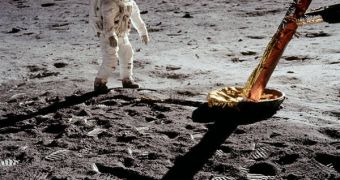According to an Australian researcher, there is a very tight connection between the amounts of dust that are in the lunar atmosphere at each given point and the time of the day when dust readings are recorded. He says that, when astronauts in the 1960s and the 1970s walked on the Moon, it was in the early hours of the lunar morning. Still, dust got in their spacesuits and made spacewalking very difficult. NASA astronauts returning to the Moon in 2017-2020 will most likely face the same problem, or an even worse one, if they land at midday, when the dust levels are the highest.
The new study, to be published in an upcoming issue of the journal Geophysical Research Letters, has been conducted by Perth, Australia-based Physicist Brian O'Brien. He argues that the dust's “stickiness” is very little understood, as are almost all other properties of the fine grains. Still, one thing is for sure: astronauts returning from the Moon have complained that the powder slipped in every crack of their costumes and helmets, lodging itself there as hard as it could.
Between 1969 and 1970, O'Brien was the principal investigator for the Dust Detector Experiment on some of the Apollo lunar landing missions. During this time, he was in charge of keeping an eye on how dust could influence the outcome of the endeavor. He has recently begun to analyze old documents, and has learned that there is a tight correlation between the amount of dust in the air and the time of day on the Moon.
“I started to revisit the personal Dust Detector Experiment (DDE) data in 2007, after learning in late 2006 that the sole source of data was with me,” he tells Space. “[The report] follows that on future lunar expeditions, powerful electrostatic adhesion of lunar dust during the middle half of each lunar day could cause greater dust problems than experienced by Apollo astronauts,” the expert adds.
O'Brien explains that there could be a large number of reasons as to why the dust suddenly changes its properties when the Sun hits it at angles higher than 45 degrees. But the expert is in tune with NASA engineers, who have said for a long time that a makeshift structure on the lunar surface should be mandatory for future missions.

 14 DAY TRIAL //
14 DAY TRIAL //